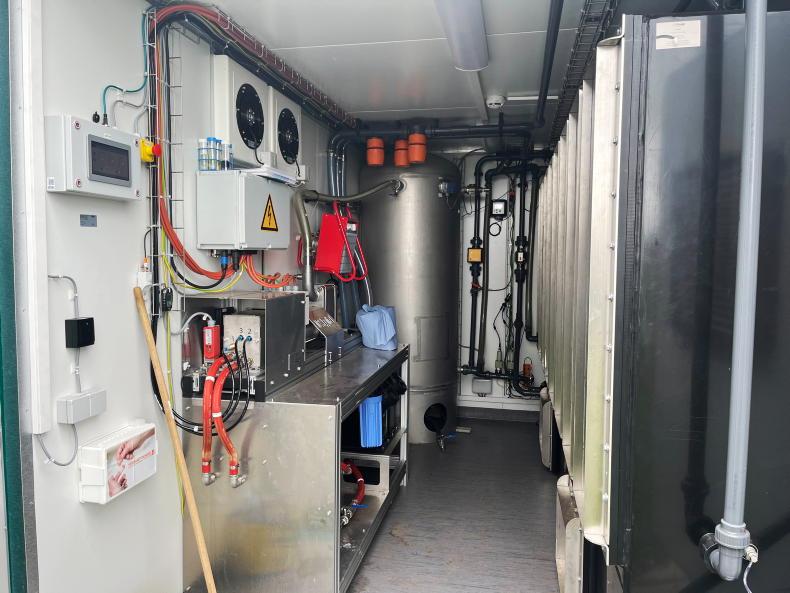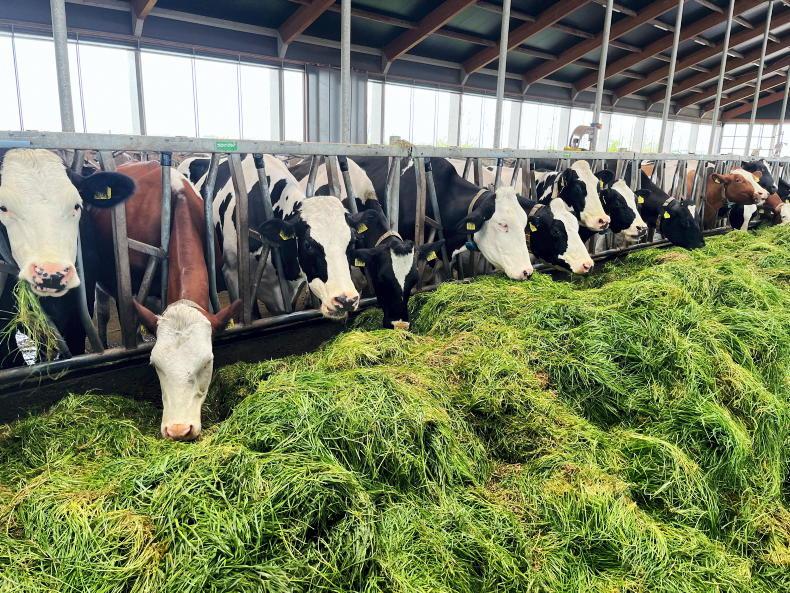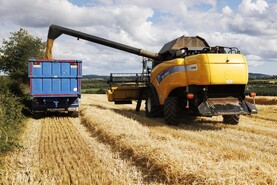On most farms, the main source of nitrogen coming on to the farm is through fertiliser, feed, slurry and the nitrogen fixed by clover. Now GEA, best known for making milking machines has a new machine on the market that can add free nitrogen from the air and put it into the slurry produced on the farm.
The process of enrichment is not free as it uses a lot of energy to convert the free nitrogen in the atmosphere and then absorb it into the slurry. The finished product is called NEO (nutrient enriched organic fertiliser) and according to GEA it acts more like a chemical compound fertiliser rather than slurry, high in nitrogen, phosphorus and potash.

The inside of the container has the plasma unit on the left and the absorption unit on the right hand side
Increasing the nutrient content of the slurry is only part of the benefits of manure enrichment, according to GEA manure processing support manager Marcus Holtkötter. He says that there are significant reductions in ammonia and methane losses and the finished product has no odour. The technology is seen as a new tool to reduce harmful ammonia emissions and to reduce the carbon footprint of dairy farms that use it.
Marcus described the process involved as being a bit like how nitrogen can be added to the soil in a lightning storm. The strong electrical currents in a lightning storm break apart the nitrogen molecules naturally present in the atmosphere into nitric oxide and nitrogen dioxide which then form plant available nitrate.

The Hoeve farm has an AD plant along with 320 cows
The GEA manure enricher is a two-step process. The first step involves replicating the effect of lightning in a plasma unit powered by a 400v electrical current. Pressurised air is sucked into the plasma unit and the electric current splits the nitrogen molecules in the air to gas form. The gas is then piped to the second stage of the process which is the absorption chamber with the slurry.
Before slurry enters this chamber the solids fraction is separated using a slurry separator and only the liquid fraction goes into the enricher. While in the absorption chamber, the pH of the slurry is reduced to a pH of 5 to 5.5. The slurry remains in the chamber for about nine hours before moving to a holding tank when the desired pH has been reached and the nitrogen added.
According to Marcus, all of the ammonia contained in NEO is stabilised with minimal losses. In ordinary slurry, between 20% and 70% of the nitrogen in the form of ammonia is lost through volatilisation. He says that the typical liquid slurry on European dairy farms contains between 3kg and 4kg of available nitrogen per 1m3 while NEO contains up to 6kg of available nitrogen including the nitrate added by the plasma unit.
Marcus says that trials conducted by GEA on commercial farms have shown a significant grass growth response over and above the same amount of nitrogen applied in the form of conventional slurry and chemical fertiliser.
The manure enricher technology is currently installed on five farms between the Netherlands and Germany. The project is supported by Unilever, one of the principal suppliers of dairy ingredients to ice cream maker Ben and Jerry’s. Unilever are involved in the project as they seek to reduce the carbon footprint of the dairy supplied to Ben and Jerry’s to below 0.6kg CO2e per kg of fat and protein corrected milk.
Most of the reductions in carbon emissions will come from the fact that methane emissions are reduced but also the need to purchase chemical nitrogen.
In terms of ammonia emissions, farmers in the Netherlands are under severe pressure to prove that they are reducing ammonia emissions in order to maintain stock numbers. Chemical products are available in the Netherlands to chemically clean slurry and reduce the ammonia emissions. An advantage of the manure enricher for reducing ammonia emissions in slurry is that it doesn’t require any consumable products to work and the process is fully automated.
Case study
One of the presumptions when it comes to reducing greenhouse gas emissions on farms using an enricher is that renewable or green energy is used in the generation of the electricity to drive the enricher.
To put it in context, the enricher operates at 50kwh of electricity which at 30c/kh means the machine costs €15/hr to operate if using bought in electricity at domestic rates in Ireland. The output is relatively low with the machine capable of processing between 8,000l and 12,000l of slurry per 24 hour period.

Cows on the Hoeve farm eating zero grazed grass
One of the first GEA manure enrichers has been installed on Andre Hoeve’s farm near Amsterdam in the Netherlands. Andre and his family are milking 320 cows and keeping 140 youngstock on a 160ha farm. The farm business has diversified with an anaerobic digestion (AD) plant producing electricity and biogas, 700kw solar panels on roofs of the farm sheds and a district heating system heating 12 local houses.
Digestate from the AD plant is used to feed into the manure enricher which was installed on the farm last winter. The digestate is sucked up into the enricher, which is located inside a steel container from an underground tank. The treated NEO is then pumped into another tank ready to be spread on the fields. Because the digestate is liquid, a slurry separator is not required on this farm.
The renewable energy generated on the farm is used to power the enricher so the running costs are lower compared to if purchased electricity was used. Marcus says that the enricher can stop and start up again without any issues, which may be useful on farms that want to sell renewable electricity to the grid at peak times, but use it to enrich slurry when the electricity price or demand for electricity is lower, such as at night time.
While chemical fertiliser is still being purchased for now on the Hoeve farm, the goal is that the enricher will eventually provide most of the nitrogen required to grow grass. The reduction in ammonia emissions is a bigger selling point for Andre than the additional nitrogen. He says that to chemically treat the slurry to reduce ammonia would cost his farm €35,000 a year in chemicals.
The farm has to export 3,000m3 of slurry per year to comply with the nitrates derogation. He says that it was costing the farm €6/t to get this slurry moved off farm but it is now costing €20 to €25/t as there is too much slurry available and it has to be moved further distances and with all the rain this spring the arable farmers don’t want to take it.
Renure
Marcus and his colleagues are keen to get NEO classed as a “renure” product. Renure is a new term in the EU and refers to recovered nitrogen from manure. In recent weeks the European Commission has published draft changes to the nitrates directive whereby renure products such as digestate from AD plants won’t be classed as organic fertiliser.
If NEO was treated in the same way, then farmers with an enricher would have less slurry that they need to export to comply with the derogation limits. Essentially, they would be converting their slurry to chemical nitrogen, meaning the stocking rate could increase beyond the derogation limit. In terms of price, Gillian Fullerton-Smith of GEA in Ireland says she expects the price of a manure enricher to be between €175,000 and €225,000 plus VAT.
Comment
This technology is not going to be a quick fix for Irish, or even Dutch dairy farmers but it is still interesting in a number of ways.
I think high electricity costs will be a stumbling block for the technology in Ireland but where cheaper electricity is available it could be a runner for some farmers.
It’s worth highlighting that ammonia emissions are not as big a problem in Ireland as in the Netherlands. However, even in the Netherlands, the investment will only make sense if the farmer gets rewarded for producing milk with a lower environmental footprint.
Ben and Jerry’s are obviously a key part of this. Just this week Mars have announced funding to reduce the carbon footprint of its milk supply in collaboration with key suppliers; Friesland Campina, DMK and Fonterra.
Manure enricher technology adds nitrogen from the air to slurry.The enricher uses a large amount of electricity. The treated manure has no methane emissions and more stable ammonia. The treated slurry is seen as a replacement for chemical nitrogen
On most farms, the main source of nitrogen coming on to the farm is through fertiliser, feed, slurry and the nitrogen fixed by clover. Now GEA, best known for making milking machines has a new machine on the market that can add free nitrogen from the air and put it into the slurry produced on the farm.
The process of enrichment is not free as it uses a lot of energy to convert the free nitrogen in the atmosphere and then absorb it into the slurry. The finished product is called NEO (nutrient enriched organic fertiliser) and according to GEA it acts more like a chemical compound fertiliser rather than slurry, high in nitrogen, phosphorus and potash.

The inside of the container has the plasma unit on the left and the absorption unit on the right hand side
Increasing the nutrient content of the slurry is only part of the benefits of manure enrichment, according to GEA manure processing support manager Marcus Holtkötter. He says that there are significant reductions in ammonia and methane losses and the finished product has no odour. The technology is seen as a new tool to reduce harmful ammonia emissions and to reduce the carbon footprint of dairy farms that use it.
Marcus described the process involved as being a bit like how nitrogen can be added to the soil in a lightning storm. The strong electrical currents in a lightning storm break apart the nitrogen molecules naturally present in the atmosphere into nitric oxide and nitrogen dioxide which then form plant available nitrate.

The Hoeve farm has an AD plant along with 320 cows
The GEA manure enricher is a two-step process. The first step involves replicating the effect of lightning in a plasma unit powered by a 400v electrical current. Pressurised air is sucked into the plasma unit and the electric current splits the nitrogen molecules in the air to gas form. The gas is then piped to the second stage of the process which is the absorption chamber with the slurry.
Before slurry enters this chamber the solids fraction is separated using a slurry separator and only the liquid fraction goes into the enricher. While in the absorption chamber, the pH of the slurry is reduced to a pH of 5 to 5.5. The slurry remains in the chamber for about nine hours before moving to a holding tank when the desired pH has been reached and the nitrogen added.
According to Marcus, all of the ammonia contained in NEO is stabilised with minimal losses. In ordinary slurry, between 20% and 70% of the nitrogen in the form of ammonia is lost through volatilisation. He says that the typical liquid slurry on European dairy farms contains between 3kg and 4kg of available nitrogen per 1m3 while NEO contains up to 6kg of available nitrogen including the nitrate added by the plasma unit.
Marcus says that trials conducted by GEA on commercial farms have shown a significant grass growth response over and above the same amount of nitrogen applied in the form of conventional slurry and chemical fertiliser.
The manure enricher technology is currently installed on five farms between the Netherlands and Germany. The project is supported by Unilever, one of the principal suppliers of dairy ingredients to ice cream maker Ben and Jerry’s. Unilever are involved in the project as they seek to reduce the carbon footprint of the dairy supplied to Ben and Jerry’s to below 0.6kg CO2e per kg of fat and protein corrected milk.
Most of the reductions in carbon emissions will come from the fact that methane emissions are reduced but also the need to purchase chemical nitrogen.
In terms of ammonia emissions, farmers in the Netherlands are under severe pressure to prove that they are reducing ammonia emissions in order to maintain stock numbers. Chemical products are available in the Netherlands to chemically clean slurry and reduce the ammonia emissions. An advantage of the manure enricher for reducing ammonia emissions in slurry is that it doesn’t require any consumable products to work and the process is fully automated.
Case study
One of the presumptions when it comes to reducing greenhouse gas emissions on farms using an enricher is that renewable or green energy is used in the generation of the electricity to drive the enricher.
To put it in context, the enricher operates at 50kwh of electricity which at 30c/kh means the machine costs €15/hr to operate if using bought in electricity at domestic rates in Ireland. The output is relatively low with the machine capable of processing between 8,000l and 12,000l of slurry per 24 hour period.

Cows on the Hoeve farm eating zero grazed grass
One of the first GEA manure enrichers has been installed on Andre Hoeve’s farm near Amsterdam in the Netherlands. Andre and his family are milking 320 cows and keeping 140 youngstock on a 160ha farm. The farm business has diversified with an anaerobic digestion (AD) plant producing electricity and biogas, 700kw solar panels on roofs of the farm sheds and a district heating system heating 12 local houses.
Digestate from the AD plant is used to feed into the manure enricher which was installed on the farm last winter. The digestate is sucked up into the enricher, which is located inside a steel container from an underground tank. The treated NEO is then pumped into another tank ready to be spread on the fields. Because the digestate is liquid, a slurry separator is not required on this farm.
The renewable energy generated on the farm is used to power the enricher so the running costs are lower compared to if purchased electricity was used. Marcus says that the enricher can stop and start up again without any issues, which may be useful on farms that want to sell renewable electricity to the grid at peak times, but use it to enrich slurry when the electricity price or demand for electricity is lower, such as at night time.
While chemical fertiliser is still being purchased for now on the Hoeve farm, the goal is that the enricher will eventually provide most of the nitrogen required to grow grass. The reduction in ammonia emissions is a bigger selling point for Andre than the additional nitrogen. He says that to chemically treat the slurry to reduce ammonia would cost his farm €35,000 a year in chemicals.
The farm has to export 3,000m3 of slurry per year to comply with the nitrates derogation. He says that it was costing the farm €6/t to get this slurry moved off farm but it is now costing €20 to €25/t as there is too much slurry available and it has to be moved further distances and with all the rain this spring the arable farmers don’t want to take it.
Renure
Marcus and his colleagues are keen to get NEO classed as a “renure” product. Renure is a new term in the EU and refers to recovered nitrogen from manure. In recent weeks the European Commission has published draft changes to the nitrates directive whereby renure products such as digestate from AD plants won’t be classed as organic fertiliser.
If NEO was treated in the same way, then farmers with an enricher would have less slurry that they need to export to comply with the derogation limits. Essentially, they would be converting their slurry to chemical nitrogen, meaning the stocking rate could increase beyond the derogation limit. In terms of price, Gillian Fullerton-Smith of GEA in Ireland says she expects the price of a manure enricher to be between €175,000 and €225,000 plus VAT.
Comment
This technology is not going to be a quick fix for Irish, or even Dutch dairy farmers but it is still interesting in a number of ways.
I think high electricity costs will be a stumbling block for the technology in Ireland but where cheaper electricity is available it could be a runner for some farmers.
It’s worth highlighting that ammonia emissions are not as big a problem in Ireland as in the Netherlands. However, even in the Netherlands, the investment will only make sense if the farmer gets rewarded for producing milk with a lower environmental footprint.
Ben and Jerry’s are obviously a key part of this. Just this week Mars have announced funding to reduce the carbon footprint of its milk supply in collaboration with key suppliers; Friesland Campina, DMK and Fonterra.
Manure enricher technology adds nitrogen from the air to slurry.The enricher uses a large amount of electricity. The treated manure has no methane emissions and more stable ammonia. The treated slurry is seen as a replacement for chemical nitrogen 








 This is a subscriber-only article
This is a subscriber-only article










SHARING OPTIONS: